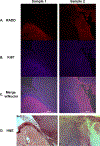DNA damage measurements within tissue samples with Repair Assisted Damage Detection (RADD)
- PMID: 33997769
- PMCID: PMC8118132
- DOI: 10.1016/j.crbiot.2019.11.001
DNA damage measurements within tissue samples with Repair Assisted Damage Detection (RADD)
Abstract
Exposures to genotoxic carcinogens and reactive species result in strand breaks and a spectrum of covalent modifications to DNA that can induce mutations and contribute to the initiation and progression of cancer. Measurements of DNA damage within tissue or tumor samples can serve as a biomarker for exposures or assess changes in DNA repair capacity relevant in cancer development and treatment. Numerous methods to characterize DNA damage exist. However, these methods are primarily applicable to isolated DNA or cultured cells, often require a substantial amount of material, and may be limited to the detection and quantification of only a handful of DNA adducts. Here, we used the Repair Assisted Damage Detection (RADD) assay to detect and excise DNA adducts using a cocktail of DNA repair enzymes, then the damage site within the genome are tagged for detection using a modified nucleotide. We previously demonstrated the RADD assay can detect lesions within isolated DNA and fixed cells, and now RADD can be used to detect DNA adducts and DNA strand breaks in formalin-fixed paraffin-embedded (FFPE) tissue samples. We verified the ability of the RADD assay to detect DNA damage in tissue by exogenously inducing DNA damage with X-rays and restriction enzymes. We also showed that RADD can be multiplexed with antibodies to detect cell cycle markers or other proteins of interest. Finally, we showed that RADD can detect DNA damage within clinically relevant ovarian tumor samples. RADD is a flexible and easy-to-use assay that allows relative damage levels to be determined within FFPE samples and allows the heterogeneity of DNA adducts and strand breaks within clinically relevant samples to be measured.
Conflict of interest statement
Declaration of competing interests The authors declare no conflicts of interest.
Figures





Similar articles
-
Single-molecule approaches for DNA damage detection and repair: A focus on Repair Assisted Damage Detection (RADD).DNA Repair (Amst). 2023 Sep;129:103533. doi: 10.1016/j.dnarep.2023.103533. Epub 2023 Jul 5. DNA Repair (Amst). 2023. PMID: 37467630 Free PMC article. Review.
-
Broad spectrum detection of DNA damage by Repair Assisted Damage Detection (RADD).DNA Repair (Amst). 2018 Jun-Jul;66-67:42-49. doi: 10.1016/j.dnarep.2018.04.007. Epub 2018 Apr 27. DNA Repair (Amst). 2018. PMID: 29723708 Free PMC article.
-
Repair Assisted Damage Detection (RADD) as a predictive biomarker for immunotherapy response in ovarian cancer.Gynecol Oncol. 2025 Jan;192:65-72. doi: 10.1016/j.ygyno.2024.11.006. Epub 2024 Nov 14. Gynecol Oncol. 2025. PMID: 39546931 Clinical Trial.
-
Rapid Quantification of Oxidation and UV Induced DNA Damage by Repair Assisted Damage Detection-(Rapid RADD).Anal Chem. 2020 Jul 21;92(14):9887-9894. doi: 10.1021/acs.analchem.0c01393. Epub 2020 Jul 8. Anal Chem. 2020. PMID: 32578422 Free PMC article.
-
Spatial mapping of the DNA adducts in cancer.DNA Repair (Amst). 2023 Aug;128:103529. doi: 10.1016/j.dnarep.2023.103529. Epub 2023 Jun 27. DNA Repair (Amst). 2023. PMID: 37390674 Free PMC article. Review.
Cited by
-
From single-molecule to genome-wide mapping of DNA lesions: repair-assisted damage detection sequencing.Biophys Rep (N Y). 2021 Dec 8;1(2):None. doi: 10.1016/j.bpr.2021.100017. Biophys Rep (N Y). 2021. PMID: 34939047 Free PMC article.
-
Acute exposure to dihydroxyacetone promotes genotoxicity and chromosomal instability in lung, cardiac, and liver cell models.Toxicol Sci. 2024 Sep 1;201(1):85-102. doi: 10.1093/toxsci/kfae075. Toxicol Sci. 2024. PMID: 38867704 Free PMC article.
-
Repair-Assisted Damage Detection Reveals Biological Disparities in Prostate Cancer between African Americans and European Americans.Cancers (Basel). 2022 Feb 17;14(4):1012. doi: 10.3390/cancers14041012. Cancers (Basel). 2022. PMID: 35205762 Free PMC article.
-
Single-molecule approaches for DNA damage detection and repair: A focus on Repair Assisted Damage Detection (RADD).DNA Repair (Amst). 2023 Sep;129:103533. doi: 10.1016/j.dnarep.2023.103533. Epub 2023 Jul 5. DNA Repair (Amst). 2023. PMID: 37467630 Free PMC article. Review.
-
Associations between DNA Damage and PD-L1 Expression in Ovarian Cancer, a Potential Biomarker for Clinical Response.Biology (Basel). 2021 Apr 29;10(5):385. doi: 10.3390/biology10050385. Biology (Basel). 2021. PMID: 33946684 Free PMC article.
References
-
- Olive PL, Banáth JP: The comet assay: a method to measure DNA damage in individual cells. Nat Protoc 2006, 1:23–29. - PubMed
-
- Smith CC, O’Donovan MR, Martin EA: hOGG1 recognizes oxidative damage using the comet assay with greater specificity than FPG or ENDOIII. Mutagenesis 2006, 21:185–190. - PubMed
Grants and funding
LinkOut - more resources
Full Text Sources
